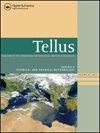M - PACE的冰核特征及其与云中冰形成的关系
IF 4.3
4区 地球科学
Q3 METEOROLOGY & ATMOSPHERIC SCIENCES
Tellus Series B-Chemical and Physical Meteorology
Pub Date : 2009-04-01
DOI:10.1111/J.1600-0889.2009.00415.X
引用次数: 125
摘要
本文介绍了2004年10月在阿拉斯加北部进行的混合相北极云实验(M-PACE)对冰核(IN)数、浓度和元素组成的航空测量结果。虽然项目平均IN浓度较低,小于1 L -1 STP,但存在显著的时空变异性,局部最高浓度接近60 L -1 STP。浸没和/或冷凝冻结似乎是主要的冻结机制,而发生在水饱和度以下的机制起较小的作用。被确定为氮氧化物的主要颗粒类型是金属氧化物/粉尘(39%)、碳质颗粒(35%)和金属氧化物/粉尘与碳质成分或盐/硫酸盐的混合物(25%),尽管元素组成存在显著差异。轨迹分析表明有本地和远程来源,包括生物质燃烧和火山灰。基于本研究和SHEBA/FIRE-ACE数据的氮素数量浓度的季节变化表明,秋季浓度相对于春季减少了约五倍。在低于- 10°C的温度下,两项研究的平均IN数浓度与大于125 μ m的云粒子的云冰数浓度比较有利。云冰数浓度在春季也增加了约2倍,但仅在有限的温度范围内。DOI: 10.1111 / j.1600-0889.2009.00415.x本文章由计算机程序翻译,如有差异,请以英文原文为准。
Ice nuclei characteristics from M‐PACE and their relation to ice formation in clouds
This paper presents airborne measurements of ice nuclei (IN) number concentration and elemental composition from the mixed-phase Arctic cloud experiment (M-PACE) in northern Alaska during October 2004. Although the project average IN concentration was low, less than 1 L -1 STP, there was significant spatial and temporal variability, with local maximum concentrations of nearly 60 L -1 STP. Immersion and/or condensation freezing appear to be the dominant freezing mechanisms, whereas mechanisms that occur below water saturation played a smaller role. The dominant particle types identified as IN were metal oxides/dust (39%), carbonaceous particles (35%) and mixtures of metal oxides/dust with either carbonaceous components or salts/sulphates (25%), although there was significant variability in elemental composition. Trajectory analysis suggests both local and remote sources, including biomass burning and volcanic ash. Seasonal variability of IN number concentrations based on this study and data from SHEBA/FIRE-ACE indicates that fall concentrations are depleted relative to spring by about a factor of five. Average IN number concentrations from both studies compare favorably with cloud ice number concentrations of cloud particles larger than 125 μ m, for temperatures less than −10 °C. Cloud ice number concentrations also were enhanced in spring, by a factor of ∼2, but only over a limited temperature range. DOI: 10.1111/j.1600-0889.2009.00415.x
求助全文
通过发布文献求助,成功后即可免费获取论文全文。
去求助
来源期刊
自引率
0.00%
发文量
3
期刊介绍:
Tellus B: Chemical and Physical Meteorology along with its sister journal Tellus A: Dynamic Meteorology and Oceanography, are the international, peer-reviewed journals of the International Meteorological Institute in Stockholm, an independent non-for-profit body integrated into the Department of Meteorology at the Faculty of Sciences of Stockholm University, Sweden. Aiming to promote the exchange of knowledge about meteorology from across a range of scientific sub-disciplines, the two journals serve an international community of researchers, policy makers, managers, media and the general public.

 求助内容:
求助内容: 应助结果提醒方式:
应助结果提醒方式:


